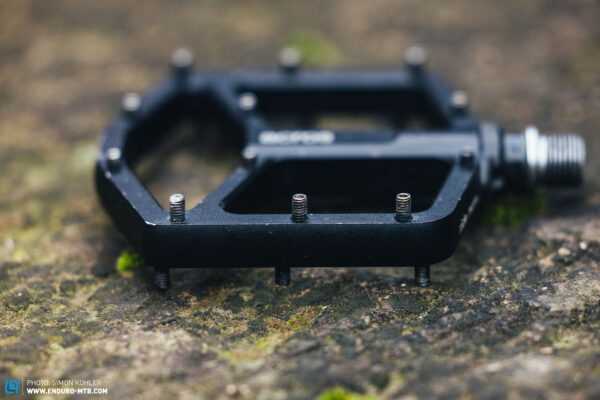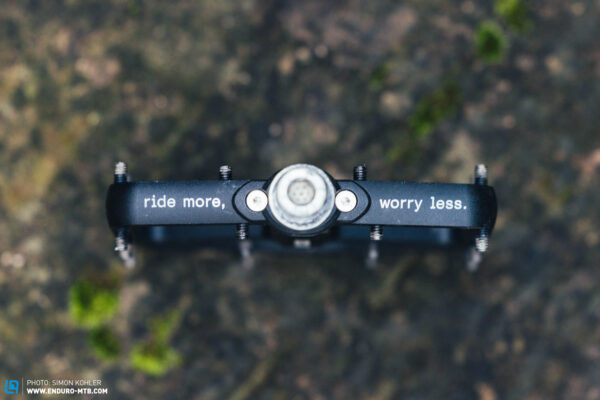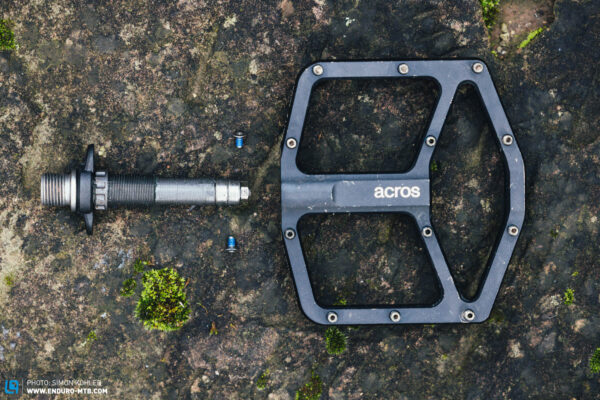Acros flatpedal – The new MTB pedals from Acros in review
Acros present their latest MTB pedals: the flatpedal. In typical Acros style, the model name is just as unassuming as the styling. And good pedals shouldn’t stand out on the trail; they should simply provide grip – if you’re thinking about them, something has gone wrong. The bearings should also hold up against mud and dirt for as long as possible. Do the Acros pedals ride as inconspicuously as they look?

With the flatpedal, Acros claim to have built MTB pedals that work just as well on rough DH tracks as on big jumps, lonely single track, or on multi-day bikepacking tours. Our big MTB pedal group test only featured their clipless pedals, but now Acros have sent us a set of their new flatpedals to put through the wringer. For € 120 you get a set of 395 g pedals – not lightweight, but about average for aluminium pedals. They have 12 pins per side. The outer pins stick out of the pedals by 6 mm, whereas the inner pins protrude by just 4 mm, thereby creating a slightly concave platform. For those who want to customise their pin configuration, the flatpedal comes with a bag of spare pins included. The pins screw into the pedals from above with a 2 mm hex key, which can become a problem if you smash the pedals into rocks and damage the pins. Once the hex socket is bent, you’ll have to try loosening the pins with pliers – assuming they haven’t snapped off completely. The 12 grub screws are spread over a large platform measuring 106 x 105 mm, while the pedal is just 12 mm thick. When it comes to colours, Acros stay true to their no-frills ethos and only offer them in black and silver. If you want something a little more unique, you can opt for custom lettering on the top.


The Acros flatpedal in detail
The details are more important for a small component like a pedal than you might think. To maximise trail fun and minimise your time in the workshop, the service intervals should be as far apart as possible. And when the time for a service comes, small details can make the difference between a quick and easy process, and a time consuming, nerve wracking ordeal. One of the first things you’ll notice is that the pedal has no small cut-outs or recesses, which makes cleaning them that much easier, as dirt hasn’t got anywhere to get stuck. However, the spindle seals and bearings aren’t to be neglected either, since they determine how frequently you’ll have to service the pedals. Acros rely on two ball bearings and a bushing. To prevent the dirt from getting into the bearings, the spindle has a double seal. In time, however, every seal will eventually leak, every bushing will wear out, and every ball bearing will start feeling rough. So that you can keep your cool while giving them a service, Acros have put a lot of thought into the design. There are no special tools required to disassemble the Acros pedals – all you need are 6 and 2 mm hex keys, and an 8 mm open-end wrench. First, you simply loosen the two screws that sit either side of the axle. Then you can lift the locking plate and twist it 90 degrees. This can then be used to unscrew the axle. On the left pedal, you must turn the axle to the left, as usual, whereas the axle on the right loosens in the opposite direction. This is so that the right axle doesn’t unscrew itself while pedalling. After removing the axle, you can use the 6 mm hex key and the 8 mm open-end wrench to loosen the nut that sits inside the axle. Finally, all of the bearings and seals can be removed from the spindle by hand. Another nice detail is a short how-to video from Acros, which explains the disassembly process step by step. Allowing you to replace anything that breaks, Acros offer 3 service kits: an axle kit for € 16, a locking plate set for € 5, and a bearing set with seals for € 12.


The Acros flatpedal on the trail
When you step onto Acros’ new MTB pedals for the first time, you won’t notice anything unusual. The platform is pleasantly large, and the slight bulge needed to accommodate the axle is so small it isn’t noticeable. The pedals offer plenty of grip and your feet feel securely planted, always remaining in place through rock gardens and over roots. Nevertheless, it doesn’t feel like your feet are glued to the pedals, which makes it easy to correct your stance if necessary. We didn’t have any problems sticking one foot out to drift into a corner Sam Hill style, or dabbing the ground to maintain our balance when a root was not as grippy as it looked. And even if the conditions get so wet that you need a pressure washer to dig your bike out from under the mud, you won’t need to worry about the pedals. Thanks to the clean design and large openings, they shed mud with ease. So, you can rest assured that you’ll have ample grip regardless of the weather.
Our conclusion on the Acros flatpedal
The latest pedals from Acros are unremarkable in the best sense of the word, and they’re fairly priced too. Acros have clearly paid attention to the details: the flatpedal can be disassembled within minutes, making easy work of greasing or replacing the bearings when needed, they offer loads of grip on the trail, and don’t pack up with mud. They almost tick all the boxes; our only gripe is that the pins screw in from the top, which can make them difficult to replace.
Tops
- clean design with large openings doesn’t get clogged up
- quick and easy to disassemble
- good grip
Flops
- pins screw in from above
For more information, visit acros-components.com
Did you enjoy this article? If so, we would be stoked if you decide to support us with a monthly contribution. By becoming a supporter of ENDURO, you will help secure a sustainable future for high-quality mountain bike journalism. Click here to learn more.
Words: Sebastian Dirscherl Photos: Simon Kohler








